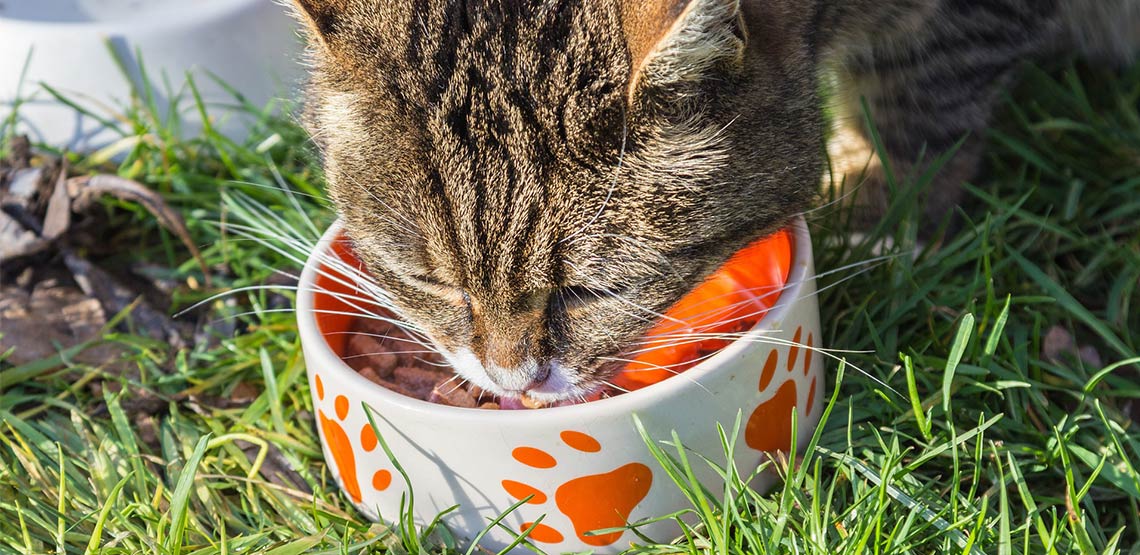How to Choose the Right Cat Food
As cat owners and lovers, we always want to buy our pets the best cat food we can afford, so it is good to know how to choose the right cat food. After all, our beloved felines deserve the very best. But, with all the ads and coupon promotions out there, how do we know which food is best for our cat’s unique needs? We must read labels, search for online help and, of course, ask your vet about ingredients, sourcing, nutritional value and supplements.
1. Understand the Ingredients
When it comes to knowing how to choose the right cat food, you should know that cats are carnivores so they must have a diet consisting mainly of meat. Grains and grain byproducts should not be fed to kittens or cats.
The meat can be red meats (beef, pork, lamb and venison), poultry (chicken, turkey and duck), or fish (tuna, salmon, cod, pollock, mackerel and sardines).
Certain organ meats from these species are also good, and liver, heart and kidney meats are fine, but be sure these meats are listed and avoid food brands that just list organ meats. Why? Because skin, feathers, eyes, bladders, stomachs, intestines, lungs, udders, etc. are all organs.
The important takeaway here is to read and understand pet food labels. The first three ingredients listed on any pet food are the most prevalent in terms of weight contribution to the recipe. Because water is a main ingredient in canned cat foods, it will often be listed as a main ingredient on the label.
Don’t be put off by this. Water is an important ingredient. In fact, many vets recommend that cats be fed canned (wet) foods because cats, as a rule, do not drink enough water.
2. Check Ingredient Sourcing
How and where ingredients are sourced is important on several levels. The health of your cat is the most important of these. Most of the pet food recalls have occurred because one or more ingredients have been accidentally tainted by a supplier.
This contamination usually results from microbials like salmonella and E. coli. It can also be caused by environmental pollutants, like pesticides and foreign material, like metal or plastic, the illegal use of endangered species or euthanized and diseased animals, or even by batching errors, like excessive levels or the omission of an important supplement or key ingredient.
We recommend that you only buy pet food products made and inspected in North America.
3. Look Into the Nutrient Values
This nutritional profile will be shown as the guaranteed analysis on the product label along with the specific ingredients and feeding suggestions. The basic macronutrient values (crude protein, crude fat, crude fiber and water) will normally be listed as a percent of total weight.
The micronutrients (vitamins, minerals and any other additives) will be shown as international units (IU) for vitamins and grams or milligrams for minerals. Carbs will usually be shown as an energy value in kilocalories (KCal/Kg or KCal/gm).
Current labeling laws do not require the non-pharm micros to be listed but some companies do it as a matter of providing good consumer information.
4. Check to for Added Supplements
This is a broad category that is best thought of in pet foods as added vitamins, minerals and amino acids. Cats in particular need to be supplemented with dietary taurine, an essential amino acid. Cats, unlike most other mammals, are especially sensitive to a taurine deficiency.
The lack of taurine will cause a host of health problems in cats including blindness, decaying teeth and even death. Because of that, all cat foods sold in North America and most countries are required to contain taurine. If you do not see taurine on the label, do not buy it.
There are many other supplements common to manufactured cat foods. Most labeled supplements are necessary vitamins and minerals like vitamins A, D, E, B complex, zinc, selenium, cobalt, iron, etc. These nutrients are necessary for the domestic cat and growing kitten.
Why? One reason is that, unlike feral and big cats in the wild, pet cats do not eat fresh kill. Instead, we feed them manufactured foods that have been depleted of these nutrients by cooking, extruding and further processing. Whether this is a good or bad thing is debatable. But, as long as we keep cats as pets, we need to feed them according to their nutritional needs.
You May Also Like:
Related Search Topics (Ads):
5. Observe the Flavor, Smell and Texture
Let’s face it, we all know that cats are finicky eaters. One cat might devour the salmon cat food you put in front of them while another will just ignore it as in “ho-hum, where’s the beef?” Because of that fact, there are a lot of cat food recipes and they are all vying for your dollar.
So, how do you know which ones are best and which ones your cat will eat? Trial and error is one way and unbiased recommendations are another. Because trial and error can be a costly and futile undertaking, we think recommendations are the way to go. For that reason, we have chosen the six of the best cat foods you can feed your cat.
Best Wet, Dry and Raw Cat Foods
- Wellness CORE Grain-Free (wet and dry).
- Instinct for Cats (raw).
- Iams Cat Food (wet and dry).
- Hill’s Science Diet (wet and dry).
- Tiki Cat (wet and dry).
- Merrick Grain-Free For Cats (wet and dry).
These cat foods have all received high customer ratings, high ingredient procurement standards, excellent labeling and website information, are readily accessible from major retailers and are in full compliance with AAFCO’s Cat Nutritional Guidelines.
Bear in mind there are a lot of high-quality cat foods available to you. Our recommended list merely shows those products we feel are superior in today’s market. These brands offer a broad range of ingredients, recipes and types.
They also each offer special needs recipes such as hypoallergenic cat foods, age-specific recipes and weight loss/weight management diets. We feel that the best weight loss cat foods are those made by Hill’s Science Diet and Iams.

